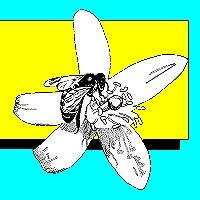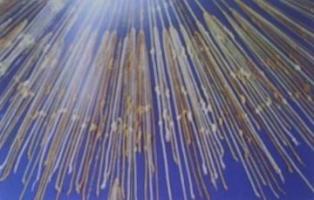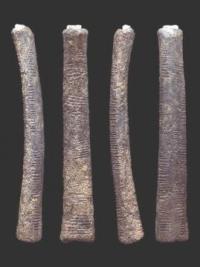APIS Volume 11, Number 11, November 1993

In this issue
- Agriculture in the Classroom
- Honey Defined
- On Resistance to Pesticides: Varroa
- African Bee Found in Third State
- Commercial Pollination--A Growth Industry?
AGRICULTURE IN THE CLASSROOM
Although most believe the concept is sound, there was never much out there to help teachers educate school children about honey bees. To fill this gap, "Plan Bee" is now available. It gets top billing in the Resource Guide, published by Florida Ag in the Classroom, and includes an 87-page lesson plan, accompanying set of slides and a list of other materials available to help teach kids (grades 1 through 6) all about honey bees. Plan Bee is available free to teachers in Florida. All that is necessary is to contact Florida Ag in the Classroom, 545 E. Tennessee St., Tallahassee, FL 32308, ph 904/487-4973. The State Coordinator is Doty Wenzel. She will be happy to discuss the program with any interested individual.
According to Florida Ag in the Classroom information fliers, "If we ignore Florida Agriculture, it may go away." The mission is to educate as many school children and teachers as possible about agriculture. The organization is non-profit, but heavily supported by the Florida Department of Agriculture and Consumer Services (the Division of Plant Industry in Gainesville was instrumental in developing Plan Bee), and has a volunteer board of directors. Beyond Plan Bee, and the resource guide mentioned above, a newsletter and booklet containing science fair ideas are published. Besides printed resources, Florida Ag in the Classroom sponsors a two and one-half day workshop each July in Gainesville for educators. As noted above, teachers can become members for free; other supporters must join by paying dues as follows: individual ($25/yr), organization ($100/yr), corporate ($250 plus $100/yr). It would be a worthy way to spend any beekeeping association's excess funds.
HONEY DEFINED
The National Honey Board has taken on a daunting task, defining honey! It may come as a revelation to some that honey has had no official definition. On further reflection, however, it is not surprising. Imagine trying to come to grips with an adequate description of a natural product that is infinitely variable. After a year-long discussion with industry representatives and others, the Board's Product Research and Development Committee has "...a document that describes and defines our product."
The actual words used in the official definition were approved October 9, 1993 and are subject to review every two years: "Honey is the nectar and sweet deposits from plants as gathered, modified and stored in the honeycomb of honey bees." That's not all of course; several honey categories and other considerations are also discussed in the three-page definition document. These include honey composition, types of honey, designation of honey sources, forms of honey, honey products, grading and methods of analysis.
Composition of honey is perhaps the most problematic topic to deal with in defining the product. Given this fact, the Honey Board has chosen to list an average, range and standard deviation for major constituents. The standard deviation is an estimation of how variable each specific item is. The higher the number, the more difference that can be found among various kinds. The standard deviations themselves show a large range from 70.9 (total protein is extremely variable) to 0.126 (fructose/glucose ratio is more consistent). The following are the actual numbers:
Average Range Standard Deviation
Fructose/Glucose Ratio 1.23 0.76-1.86 0.126
Fructose,% 38.38 30.91-44.26 1.77
Glucose,% 30.31 22.89-40.75 3.04
Minerals (Ash),% 0.169 0.020-1.028 0.15
Moisture, % 17.2 13.4-22.9 1.46
Reducing Sugars, % 76.75 61.39-83.72 2.76
Sucrose, % 1.31 0.25-7.57 0.87 Total
Acidity, meq/kg. 29.12 8.68-59.49 10.33 True
Protein, mg/100g. 168.6 57.7-567 70.90Although the percentage of fructose and glucose constituents are about the same in honeys, glucose is more variable with a standard deviation of 3.04 as opposed to fructose's 1.77. Fructose is the major sugar component which provides the extreme sweetness in honey. This sugar also reduces possible crystallization in the product; Florida tupelo honey is well known for its high fructose content and tendency not to "sugar." The percentage of sucrose in honey has a larger range than might be expected. Citrus honey from Florida has been rejected in some international markets because of its relatively high sucrose content, which is also thought to promote crystallization. Obviously, some honeys are much more proteinaceous than others. Perhaps this will result in some interesting claims by producers in response to the well-known declaration that honey is nothing more than carbohydrate!
Of all the numbers presented above, those with reference to percentage of water are perhaps most significant to honey judges. The standard for moisture content in honey shows has traditionally been 18.6%. Does the upper bound shown in the official definition (22.9%) mean that judges will have to accommodate honey in shows with what heretofore was considered an unacceptably high moisture content? In any case, this information will require changes in ENY 129 Honey Judging and Standards and ENY 130 Moisture in Honey, available from this office in limited supply. The official definition does incorporate current U.S. standards and grades of extracted and comb honey which are quoted at length in the above fact sheets.
ON RESISTANCE TO PESTICIDES: THE VARROA CONNECTION
There has been a good deal of talk in these pages about the possibility of the Varroa mite becoming resistant to Apistan (R). To date, we have little evidence that this is indeed happening. It seems that many reports of resistance are really cases of reinfestation by Varroa from nearby untreated colonies or improper treatment by the beekeeper. Nevertheless, those with experience in the field indicate that mites developing resistance to Apistan (R) is a real possibility.
An article by Drs. John Capinera, Chair, and Majorie Hoy, Eminent Scholar, at the Entomology-Nematology Department, University of Florida, in the November 1993 issue of Florida Grower and Rancher, sheds important light on development of resistance by insects and mites to pesticides. It begins, they say, with an all-too-predictable and sad scenario:
"A grower observes that a treatment which formerly was effective for pest control no longer works quite as well. Blaming it on the weather, the applicator, or the product is the natural response. This is followed by increased frequency with higher rates of application which prove temporary relief. But soon this also fails to provide satisfactory pest control. Eventually the problem is diagnosed as pesticide resistance. The grower scrambles to find another pesticide which controls the pests but in doing so experiences crop losses, higher pesticide costs--and increasingly-- lack of alternative pesticides."
Examples of the above scenario, according to the authors, include control of leafminer on celery, diamondback moth on cabbage, sweetpotato whitefly on tomato, green peach aphid on potato, broad mite on peppers and two-spotted spider mite on strawberries. The seriousness of the problem is indicated by the fact that by 1984, some 39 percent of 171 medical and 61 percent of 164 agricultural insects and mites showed resistance to pesticides. Most resistance has been found to the older chlorinated hydrocarbon and organophosphate compounds, but it is also being seen in the newer carbamates and pyrethroids.
The authors suggest that resistance principally comes from species' ability to metabolize and detoxify poisons, but it could also be due to behavior and other factors. They list the major causes for pesticide resistance developing in pests as (1) high reproductive capacity, (2) many generations per year, (3) parthenogenesis, (4) high survivorship, (5) immigration and (6) high initial frequency of the genes responsible for the resistance. Experience indicates that resistance is also promoted by: (1) close chemical relationship between previously used insecticides, (2) high persistence of materials used, (3) broad-scale applications, (4) frequent applications and (5) sole reliance on chemical control. Finally, the authors conclude it is not possible to predict when or whether resistance will occur or why there is resistance to some pesticides and not others.
A closer look at the Varroa situation reveals that many of the conditions above are present which favor it acquiring resistance to fluvalinate. For example, the Varroa mite does produce several generations per year; in fact it can reproduce whenever there is brood. This means most of the time in Florida. It can also be characterized as a mite with a high reproductive capacity; for every mated female in a colony, several daughters may emerge to continue the cycle. If each of these produces a number of daughters, an exponential rate of increase results. Parthenogenesis (reproduction without fertilization of the egg) does not seem to be an important factor in Varroa reproduction. Perhaps of most significance is Varroa's a high rate of migration from infested to treated/noninfested colonies, as shown both within and among in beekeeping operations (see the August and October issues of this newsletter). In general, therefore, it can be said that a majority of biological factors affecting development of resistance are present in Varroa.
Operational considerations which effectively promote resistance to insecticides by Varroa may also be working in concert with the biological factors discussed above. Presently, there is only one chemical labelled for controlling Varroa in a living beehive. This is Apistan (R); it contains the active ingredient fluvalinate, a synthetic pyrethroid. Fluvalinate is a contact poison that kills Varroa. It will also poison bees, but the concentration in Apistan (R) is so low that it does not appear to harm the larger-bodied bees. Unfortunately, the product is being used on a large scale and frequent applications are often necessary, especially in subtropical climates. In addition, it is known that beekeepers at present must rely totally on this one pesticide to economically reduce the Varroa population in colonies. This short-range fix could lead to a long-term disaster, should Varroa become resistant to Apistan (R). There are simply no other materials legally available which effectively reduce the mite population.
Whether alternative chemicals would become available for Varroa control is problematic. The authors of the article in Florida Grower and Rancher say that pesticides are increasingly concentrated in the hands of only a few manufacturers that choose to market only to producers of large crops like corn and cotton. Fewer, in some cases, no, options exist for developing chemicals for many minor uses. This includes beekeeping. Thus, the authors conclude, the risk of development of resistance to pesticides must be minimized in these minor crops. For beekeepers, this means that Apistan (R) should be treated like the rare commodity it really is.
Just how precious is Apistan (R)? In many areas of the world, for almost 30 years, there was no effective control for Varroa. By the time of the product's introduction, over 140 chemicals had been tried, most unsuccessfully, in controlling this devastating parasite. The result was large-scale colony loss where ever the mite was introduced. The U.S. beekeeping community, therefore, should count itself very lucky indeed to have had a legal and effective pesticide become available soon after Varroa was introduced. Illegally using Apistan (R) or using alternative formulations of fluvalinate risks reducing the effectiveness and ultimately, the loss of this product. It should be the fervent hope of every apiculturalist that the product maintains its effectiveness, prolonging as long as possible the addition of "Varroa on honey bees" to the lengthening list of pests which have established resistance to pesticides.
AHB FOUND IN THIRD STATE
New Mexico has now been added to the list of states confirmed to have African bees. In addition, there have been several finds in Arizona, one very close to the California border, and Ector has become the 69th Texas county to be quarantined.
With the AHB find in Cotton City, N.M., the New Mexico Cooperative Extension Service began working closely with the New Mexico Department of Agriculture and other agencies to educate the state's residents on learning to live with AHBs, according to L. Michael English, extension entomologist at New Mexico State University. The educational campaign is being directed at all age groups, starting with school children. Primary education targets also include highway department workers, pest control operators and others likely to come in contact with bees.
POLLINATION--A GROWTH INDUSTRY?
I have participated in two panels this year at beekeepers' meetings on commercial pollination. At least for some, it is a growth industry. For the first time this year, Florida bees were trucked to California for almond pollination!
Uniform advice from these panels was that a quality pollination service takes commitment. The beekeeper must always be ready to get bees in and move them out of fields with very short notice, and some kind of a backup plan should be in place in the very real case that things go wrong. One must develop a long-term personal relationship based on trust with the customer. A key to this is communication. Successful pollinators are regularly in contact with customers, even during the off season. They send out reminders and make phone calls in advance of the coming season to try to assess their capabilities and the growers' needs. One outfit writes a newsletter that includes information on a wide variety of topics.
I was happy to hear that at least one commercial pollinator has used information I published about pollination in his marketing efforts. "Pollination of Citrus by Honey Bees," and "Beekeeping: Watermelon Pollination," two papers I wrote for commercial grower conventions, are both available from County Extension Offices on CD ROM 7 and 8. In addition, I continue to have a supply of ENY 110 Sample Pollination Agreement, available on request.
The message from participants on both panels was clear. Given quality service, growers are not opposed to paying top dollar for pollination fees. There seems to be no better time than now for every beekeeper to look closely at commercial pollination as an alternative enterprise.
Malcolm T. Sanford
Bldg 970, Box 110620
University of Florida
Gainesville, FL 32611-0620
Phone (904) 392-1801, Ext. 143 FAX: 904-392-0190
INTERNET Address: MTS@GNV.IFAS.UFL.EDU




















